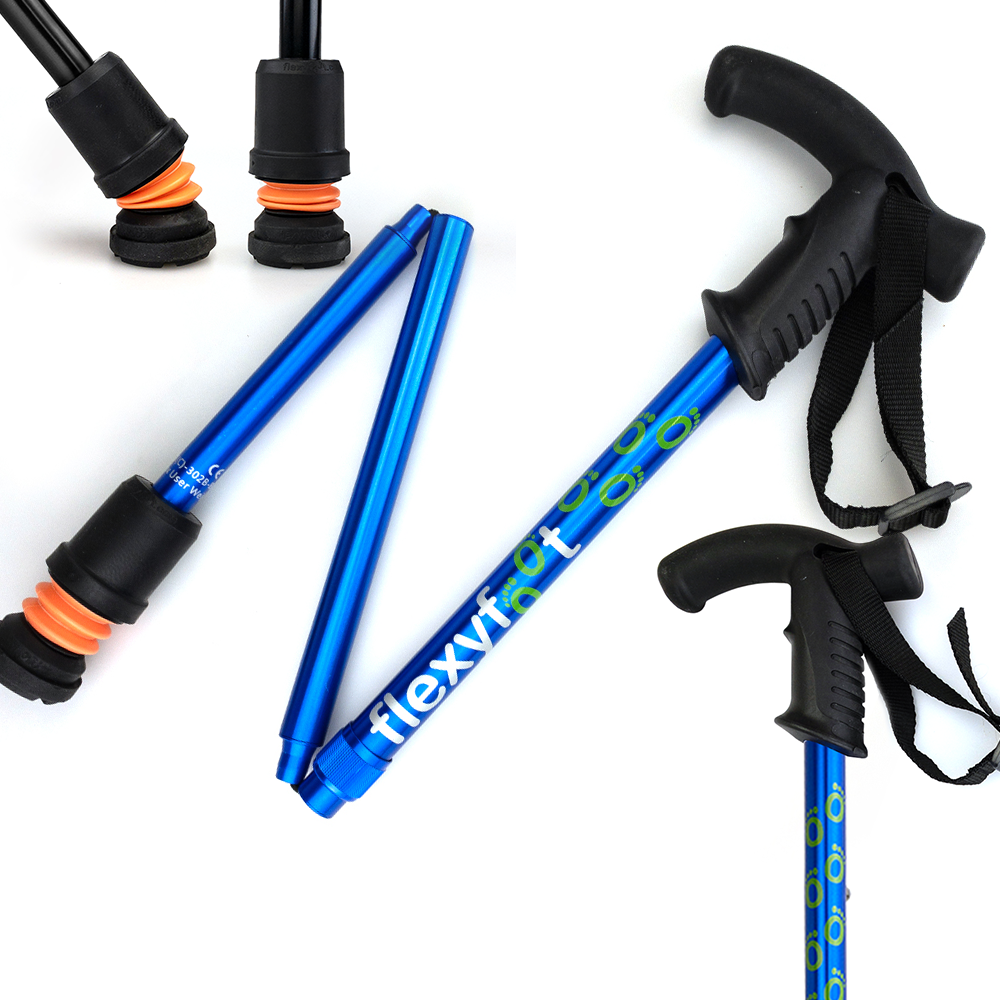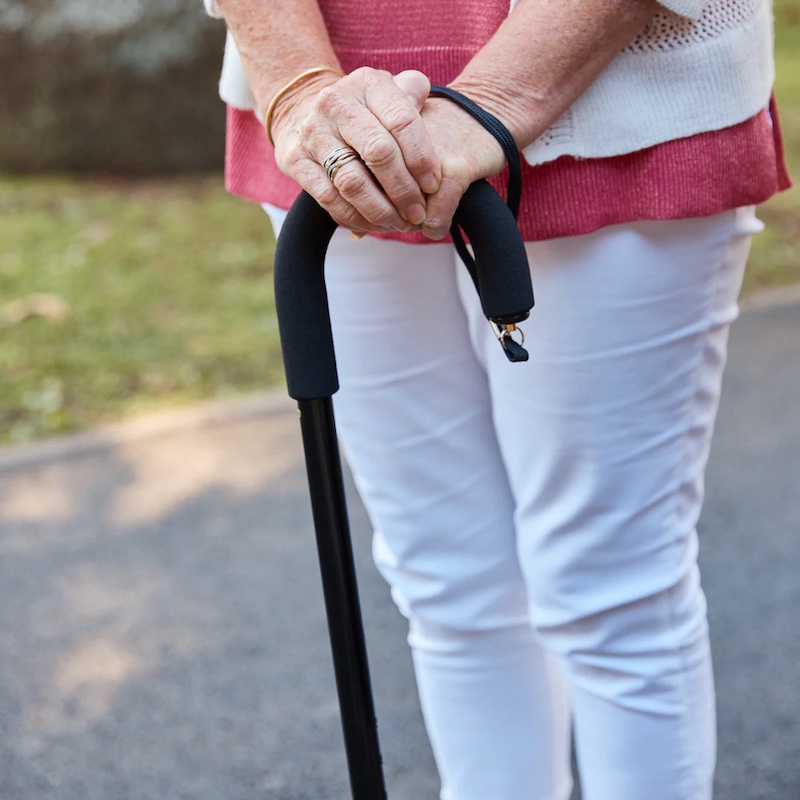Importance of Walking Aids for Hip Pain Relief
Walking aids are crucial for those struggling with hip pain. They provide needed support, easing discomfort and improving mobility. Painful hips can limit daily activities, making simple tasks demanding. A walking stick or cane takes on part of the body weight, reducing stress on the hip joint. This relief can lead to increased independence in daily life.
Using a walking aid, like a walking stick, can lessen hip pain substantially. When used properly, it serves as an extension of the body’s balance system. It helps maintain stability while distributing weight away from the painful hip. Not only does this improve comfort, it may also prevent further injury.
Patients with arthritis or those recovering from hip surgery, injury, or other hip-related conditions can benefit greatly. A walking stick complements other treatments and therapies for hip pain. It should be used in coordination with professional medical advice for best results.
In summary, a walking stick is more than just a tool. It’s a source of relief, safety, and greater mobility for individuals experiencing hip pain. Always remember to consult a healthcare professional for personalized advice on managing hip pain.

Selecting the Right Walking Stick
Selecting the right walking stick is a key step in managing hip pain effectively. The ideal walking stick should be comfortable, sturdy, and of the correct height. Here are several factors to consider when choosing a walking aid:
- Height: The walking stick should reach the crease in your wrist when you stand upright, with your arms at your sides. This ensures that your elbow is slightly bent when you use it, promoting better posture and balance.
- Handle: Opt for a handle that feels comfortable in your hand. Ergonomic handles can reduce stress on your joints and prevent fatigue during use.
- Material: Walking sticks made of lightweight materials like aluminum are easier to carry and maneuver. However, wooden sticks can offer more aesthetic appeal and durability.
- Tip: A rubber tip provides added traction and stability, particularly on slippery or uneven surfaces. It’s essential for safety, so always check it’s in good condition.
- Adjustability: An adjustable walking stick allows you to modify its height. This is especially useful if you are recovering from an injury and your needs change over time.
- Support: If you need additional support, consider a walking stick with a broader base or one with multiple tips, often referred to as quad canes.
In conclusion, take your time when selecting a walking stick. Trying several options and styles will help you find the one that best suits your needs and lifestyle. Remember, the right walking stick can make a big difference in your comfort and mobility levels.
Basic Walking Stick Usage for Hip Support
Using a walking stick for hip pain can be a game changer. Here’s how to do it right:
- Hold It Correctly: Keep the stick on your strong side, opposite the painful hip.
- Move In Sync: Step with your bad leg and the stick at the same time.
- Maintain Balance: Let the stick and your good leg share the weight equally.
- Keep It Close: Don’t extend the stick out too far; it should stay within easy reach.
- Adjust Height Properly: Your elbow should bend slightly when you hold the stick.
- Choose Right Handle: Ensure the grip is comfortable and doesn’t strain your hand.
Practice these techniques until they feel natural. With continued use, a walking stick can help alleviate hip pain and improve your quality of life.
Safety Tips for Walking with a Walking Stick
Walking safely with a walking stick is paramount. Below are essential guidelines to ensure your safety while using a walking stick for hip pain relief:
- Stay Alert: Keep your eyes forward to spot any obstacles in your path. It helps avoid trips and falls.
- Remove Hazards: Clear away loose rugs, cords, and clutter that can snag your walking stick.
- Proper Footwear: Wear shoes with non-slip soles to prevent slipping while walking.
- Dry and Clean Tips: Check that the rubber tip of your walking stick is dry and free from wear. Replace it when worn out.
- Steady Pace: Walk at a comfortable pace. Rushing can throw off your balance and strain your hip.
- Lean On Me: Use the walking stick to support your weight, not drag it. It should be an aid, not a hindrance.
- Mind the Pets: Be cautious around pets and kids to avoid unpredictable movements.
- Hand Position: Grip your walking stick firmly but comfortably to maintain control.
- Illumination Matters: Ensure good lighting in your home, especially at night, to see clearly.
- Handle Wet Surfaces: Take extreme care on wet or icy surfaces. If possible, avoid them altogether.
By adhering to these safety tips, you can improve your confidence and stability when using a walking stick for hip pain. Remember not to solely rely on the walking stick when rising from or sitting down in chairs; always use the chair arms to support your movements.
Walking Stick Techniques for Various Terrains
Navigating different terrains with a walking stick requires specialized techniques. Here’s what to consider on various grounds:
- Solid Grounds: On stable surfaces like sidewalks or floors, use your stick for light support. Move it in sync with your opposite leg to maintain balance.
- Uneven Terrains: When walking on rocky or irregular surfaces, plant your stick firmly. This helps to stabilize your body before taking each step with your painful hip.
- Soft Surfaces: On soft grounds such as grass, place the stick slightly deeper into the surface. This prevents it from slipping and provides a secure anchor for each step.
- Slopes: Ascending a slope, lean slightly forward, and use the stick to pull you up. Descending, place the stick ahead for stability and to control your descent pace.
- Slippery Surfaces: On ice or wet ground, take short, cautious steps. Apply gentle pressure on the stick to test traction before committing your weight.
- Transitions: Changing from one type of terrain to another, pause to adjust your grip and stick position. This ensures continuous support as the ground changes.
Each terrain presents unique challenges; mastering these techniques will provide confidence and safety. If you face a new and difficult terrain, practice with assistance first to ensure your technique is secure.
Advanced Walking Stick Techniques for Stairs and Curbs
Mastering stairs and curbs with a walking stick requires skill and practice. Apply these advanced techniques for safe and efficient navigation:
When facing stairs, your walking stick becomes crucial for balance and support. Follow these steps:
- Using a Banister: If available, grasp the handrail with one hand and hold your walking stick in the other.
- Ascending Steps: Step up with your stronger leg first, followed by your weaker leg and walking stick together.
- Descending Steps: Lead with your walking stick and weaker leg when stepping down, then follow with your stronger leg.
- Even Pacing: Maintain a steady and slow pace to avoid missteps or losing balance.
Managing Curbs
Curbs can be tricky, but with practice, your walking stick can help you navigate them effortlessly:
- Approach Squarely: Face the curb directly and establish a firm footing before stepping.
- Up the Curb: Move the stronger leg up first, then the walking stick and weaker leg.
- Down the Curb: Place the walking stick on the lower level, step down with the weaker leg, then the stronger one.
- Pause for Balance: Always secure your balance before proceeding to walk.
Regularly applying these techniques will enhance mobility and confidence in using a walking stick over varied and challenging terrains.
Adjusting to Life with a Walking Stick for Hip Pain
Living with hip pain can alter your daily activities. Adapting to a walking stick may seem daunting at first, but with time, it can significantly ease your mobility challenges. Here are tips to help you adjust:
- Gradual Introduction: Start by using your walking stick around the home. Get comfortable moving through familiar spaces.
- Mind Your Posture: Always stand up straight. Keep the walking stick at the right height to prevent slouching.
- Build Confidence: Use your stick often. Over time, this builds trust in the support it provides and improves confidence.
- Stay Consistent: Carry your walking stick everywhere. Consistency will make it a seamless part of your movement.
- Join Support Groups: Meet others using walking aids. Sharing experiences can offer you practical tips and emotional support.
- Modify Your Home: Rearrange furniture to create clear paths. Ensure your home is walker-friendly to avoid trips and falls.
- Seek Training: A physiotherapist can teach you proper techniques. They tailor strategies to fit your lifestyle and physical condition.
With patience and practice, you can make the walking stick a beneficial part of managing your hip pain. It’s not a sign of weakness but a smart way to maintain your independence and activity levels. If you struggle to adapt or have concerns, consult a healthcare provider for further guidance.
When to Consult a Professional for Hip Pain and Walking Aid Use
While walking sticks can provide great support for hip pain, there are times when professional advice is essential. It is crucial to seek expert guidance in certain situations to ensure that the use of a walking aid is beneficial and not detrimental to your condition. Here is a rundown of scenarios when consulting a healthcare professional is advised:
- Initial Pain Assessment: If you’re experiencing hip pain for the first time, it’s important to get diagnosed by a doctor.
- After Injury: Post-injury, professional help can determine if a walking stick is right for you.
- Chronic Pain Changes: Any new or intensifying pain should be checked promptly.
- Walking Aid Adjustments: If your walking stick seems off balance or uncomfortable, ask for an expert’s help in adjusting it.
- Lack of Improvement: If there’s no relief after consistent walking stick use, a healthcare provider should reassess your situation.
- New Physical Challenges: When facing additional mobility issues, it’s best to get professional input.
- Post-Surgery: After hip surgery, consult with professionals on safe walking aid usage.
- Part of a Therapy Plan: Include walk aid queries in your regular check-ups with physiotherapists or occupational therapists.
Remember, a walking stick can aid hip pain but it’s not a cure-all. Regular consultations with healthcare professionals ensure that your walking stick use is effective and aligned with your overall treatment strategy. Stay vigilant about your health and don’t hesitate to ask for professional advice when needed.


